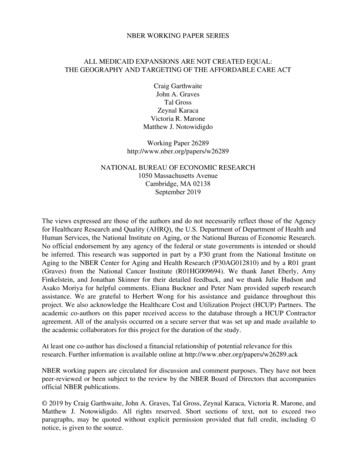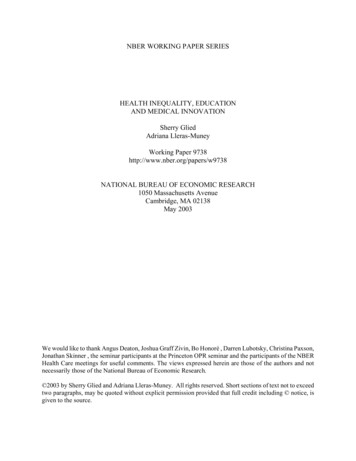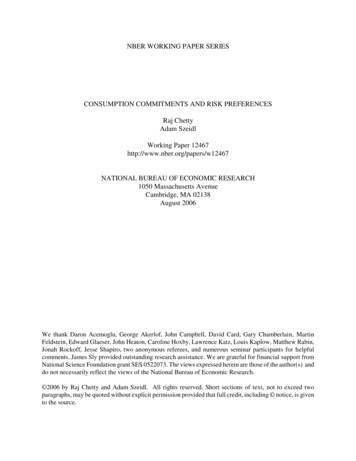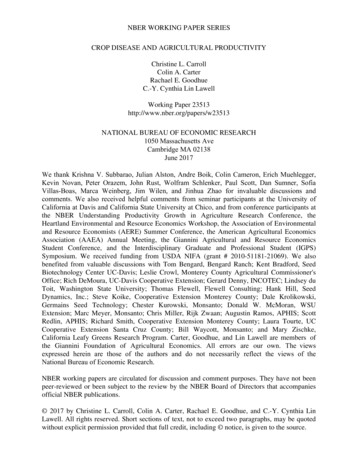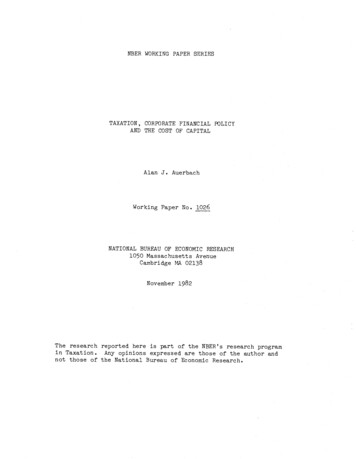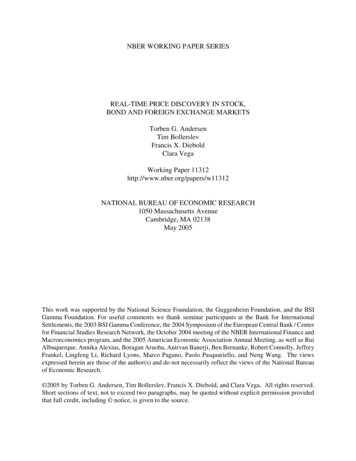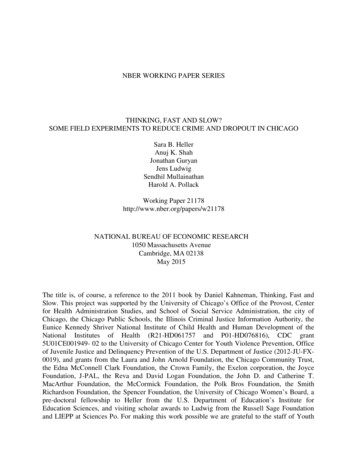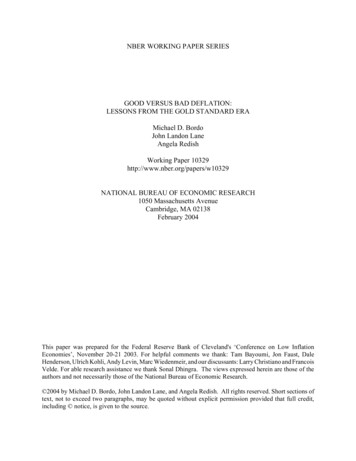
Transcription
NBER WORKING PAPER SERIESEXPENDITURE SWITCHING AND EXCHANGE RATE POLICYCharles EngelWorking Paper 9016http://www.nber.org/papers/w9016NATIONAL BUREAU OF ECONOMIC RESEARCH1050 Massachusetts AvenueCambridge, MA 02138June 2002This paper was prepared for the NBER Macro Annual 2002. The National Science Foundation has supportedthis research through a grant to the University of Wisconsin – Madison. I thank the discussants, Karen Lewisand Pierre Olivier Gourinchas, as well as Mick Devereux and Ken West for helpful comments, and AkitoMatsumoto and Shiu-Sheng Chen for excellent research assistance. The views expressed herein are thoseof the author and not necessarily those of the National Bureau of Economic Research. 2002 by Charles Engel. All rights reserved. Short sections of text, not to exceed two paragraphs, may bequoted without explicit permission provided that full credit, including notice, is given to the source.
Expenditure Switching and Exchange Rate PolicyCharles EngelNBER Working Paper No. 9016June 2002JEL No. F3, F4ABSTRACTNominal exchange rate changes can lead to "expenditure switching" when they change relativeinternational prices. A traditional argument for flexible nominal exchange rates posits that when pricesare sticky in producers' currencies, nominal exchange rate movements can change relative prices betweenhome and foreign goods. But if prices are fixed ex ante in consumers' currencies, nominal exchange rateflexibility cannot achieve any relative price adjustment. In that case nominal exchange rate fluctuationshave the undesirable feature that they lead to deviations from the law of one price. The case for floatingexchange rates is weakened if prices are sticky in this way. The empirical literature appears to supportthe notion that prices are sticky in consumers' currencies. Here, additional support for this conclusion isprovided. We then review some new approaches in the theoretical literature that imply an importantexpenditure-switching role even when consumer prices are sticky in consumers' currencies. Furtherempirical research is needed to resolve the quantitative importance of the expenditure-switching role fornominal exchange rates.Charles EngelDepartment of EconomicsUniversity of Wisconsin1180 Observatory DriveMadison, WI 53706-1393and NBERcengel@ssc.wisc.edu
1. IntroductionExchange-rate flexibility, it has been argued, is useful because it facilitates relative priceadjustment among countries. Currency depreciation is a quick and painless way to lower domestic pricesrelative to foreign prices. Much attention has been paid recently to the benefits of exchange-rate stabilityin emerging economies. That literature has focused on the potential for greater monetary and financialstability from either fixing exchange rates, or taking more extreme measures such as adopting a currencyboard or dollarizing. But that analysis is not directly applicable to the choices facing many advancedcountries – such as the decision to adopt the euro for some European countries. These countriesuniformly have stable monetary policy (at least as stable as the policy conducted by the European CentralBank) and have deep, well-regulated financial markets. The economic benefit of adopting the euro lies inthe increased efficiency of transactions and the elimination of uninsurable exchange-rate risk. On theother hand, a country adopting the euro cedes its monetary policy to the European Central Bank, and nolonger has the option of using monetary policy to respond to local conditions. Furthermore, adopting theeuro eliminates one possible avenue for adjustment between countries – the relative price changesinduced by exchange rate movements. It is this latter effect that is the focus of this study.Recent evidence has found that consumer prices in rich countries are not much affected bynominal exchange rate changes in the short run.1 This finding may imply that nominal exchange ratechanges do not play much of a role in changing relative prices of goods. If consumer prices are notresponsive to exchange rates, then a depreciation of the home currency, for example, does not increasemuch the price that consumers pay for imported goods. However, there are other interpretations of theevidence on exchange rates and consumer prices. For example, there might be important relative priceeffects but not for final consumer goods. One possibility is that intermediate firms substitute between1I have been the perpetrator of some of this literature: for example Engel (1993, 1999) and Engel and Rogers (1996,2001). Other works include Rogers and Jenkins (1995), Obstfeld and Taylor (1997), Parsley and Wei (2001a,2001b), and Crucini, Telmer, and Zachariadis (2001). Mussa’s (1986) classic paper stimulated much of thisresearch.1
domestic and foreign goods based on relative price changes, but set prices for consumers in a way that isunresponsive to exchange-rate changes.The extent to which exchange rates alter relative prices may be important for determining thedesirability of exchange-rate flexibility among advanced nations. Milton Friedman (1953), an earlyadvocate of flexible exchange rates, argued that one advantage of floating rates is that they could allowrapid change in relative prices between countries (p. 162):“A rise in the exchange rate makes foreign goods cheaper in terms of domestic currency, eventhough their prices are unchanged in terms of their own currency, and domestic goods more expensive interms of foreign currency, even though their prices are unchanged in terms of domestic currency. Thistends to increase imports [and] reduce exports.”This passage makes two assumptions: that goods prices are unchanged in the currency of theproducer of the good, and that there is significant pass-through of the exchange rate change to the buyerof the good. On the nominal price stickiness, Friedman argues that the choice of exchange-rate regimewould matter little if nominal goods prices adjusted quickly to shocks (p. 165):“If internal prices were as flexible as exchange rates, it would make little economic differencewhether adjustments were brought about by changes in exchange rates or by equivalent changes ininternal prices. But this condition is clearly not fulfilled. At least in the modern world, internal pricesare highly inflexible.”In assessing this relative-price effect and its significance for the choice of exchange-rate regime,Friedman is certainly correct to emphasize the importance of nominal goods price stickiness. As Buiter(1999) has forcefully emphasized, the decision to join a monetary union, or the choice of an exchangerate regime, is a monetary issue. Relative-price behavior is usually independent of monetary regime in aworld of perfect goods price flexibility. The choice of monetary regime in this case only matters forshort-run adjustment problems – the period during which nominal prices are adjusting.The pioneering work of Obstfeld and Rogoff (1995, 1998, 2000a) has assumed that nominalprices are fixed in the producers’ currencies, so that prices for consumers change one-for-one in the shortrun with changes in the nominal exchange rate. This is exactly the assumption of Friedman. I shall callthis the PCP (for “producer-currency pricing”) model. The Obsteld-Rogoff (hereinafter, OR) modelsoffer a sound analytical foundation for the claim that flexibility of exchange rates is desirable in this2
setting.2They derive three important results: (1) Exchange-rate flexibility achieves relative priceadjustment under PCP pricing. Indeed, in their models, flexible exchange rates are a perfect substitute forflexible nominal prices. That is, the flexible nominal price allocations are achieved with PCP pricing butflexible exchange rates. (2) The policy that achieves the flexible price allocation is a constrained Paretooptimum. The monetary authorities can do no better. (3) This optimal policy is completely self-oriented.No policy coordination across countries is required or desirable. In this sense, perfectly flexible exchangerates are optimal.The key role of nominal exchange rate flexibility in these models is that it allows for expenditureswitching. That is, in the presence of real shocks that are specific to one country (such as productivityshocks, labor supply shocks, government spending shocks, etc.), nominal exchange rate changes allowadjustment of relative prices of goods across countries. These changes in relative prices can replicate thechanges in relative prices that occur in flexible price economies. For example, a country that experiencesa productivity increase should experience a decline in the price of its output that induces a switch inexpenditures toward the domestic product. In the PCP framework, even though nominal prices are stickyin the producers’ currencies, this relative price decline can be accomplished by nominal currencydepreciation.A number of recent papers (Betts and Devereux (1996, 2000), Chari, Kehoe, and McGrattan(2000), and others) have examined OR-style models in which nominal prices are set in advance in thecurrency of consumers. In that case, nominal exchange rate changes do not, in the short run, change anyprices – nominal or real – faced by consumers. I shall call this the LCP (for “local-currency pricing”)model. Devereux and Engel (2001) have examined monetary policy in this setting, and have concludedthat there is no case for nominal exchange rate flexibility – indeed, fixed exchange rates are preferred.The size of the expenditure switching effect is important in international macroeconomics notonly for how it might influence optimal monetary policy.2The literature dating back to Mundell (1968)See Lane (2001) for an excellent general survey of the work stimulated by Obstfeld and Rogoff.3
and earlier3 has emphasized the expenditure-switching role of nominal exchange rate changes intransmitting business cycle fluctuations between countries. On the other hand, Krugman (1989) hasargued that nominal exchange rate volatility might be accentuated if the expenditure-switching effect issmall. The smaller the effect of exchange rate changes on relative prices, and hence on relative demands,the larger the exchange-rate change is required to reach equilibrium.4Sections 2, 3, 4, and 5 of the paper lay out the framework of the new open-economymacroeconomics. I discuss why floating exchange rates are desirable under PCP, but fixed exchangerates may be optimal under LCP. Empirical evidence supports the notion that consumer prices are notvery responsive in the short run to nominal exchange rate changes. Section 6 reviews some of thatempirical evidence, and adds some new supporting evidence.But the apparent small response of consumer prices to exchange rate changes in the short rundoes not necessarily imply that nominal prices are sticky in consumers’ currencies, or that theexpenditure-switching effect is small. In OR (2000b), transportation costs and distribution costs increasethe cost of imported goods, and serve to segment national markets. Even if imported goods are nearlyperfect substitutes for domestically produced goods, they may not be consumed in great quantity becausetheir cost is higher. In that case, an exchange rate change will have only a small effect on the consumerprice index.A related approach observes that the actual physical good is only a small part of what theconsumer buys. The consumer also pays for the nontraded marketing, distribution and retailing servicesthat bring the good to the buyer. Perhaps these costs are quite large, and dominate the cost of the physicalgood. If so, the influence of exchange-rate changes on real allocations is likely to be small, since theexchange rate change only affects a small part of the cost of the good cum service purchased by theconsumer. This is the approach taken by McCallum and Nelson (2000).3See Obstfeld (2001) for a survey of pre-Mundellian literature.Devereux and Engel (2002) explore this argument and its limitations in the context of new open-economy macromodels.44
In both of these models, nominal consumer prices of imported goods are not sticky. But somenew evidence will be presented in sections 7 and 8 that suggests these models are, at best, only a smallpart of the explanation for the lack of responsiveness of consumer prices to exchange rate changes. Itseems likely that there is a significant degree of nominal consumer price stickiness. However, stickyconsumer prices in themselves do not necessarily rule out an important expenditure switching effect.Obstfeld (2001) and Devereux, Engel, and Tille (1999) model imported goods as intermediates inthe production of final consumer goods. In Obstfeld, there are domestic substitutes for the import, whilein Devereux, Engel, and Tille there are not. When there are substitutes, the importer might switchbetween the imported intermediate and the locally produced alternative when the exchange rate changes.Obstfeld argues that in this type of economy, there may indeed be a significant expenditure-switchingeffect. It is not consumers who switch between imports and locally produced goods, but rather localproducers who combine intermediate goods to make the final consumer product. It is both the degree ofpass-through and the amount of substitutability that determine the strength of the expenditure-switchingeffect. Section 9 explores these models, and Section 10 sets out some directions for future research.2. Models of exchange rates and relative pricesIn this and the next three sections, I examine some simple “new open economy macroeconomic”models. These models are fully integrated equilibrium models in which households and firms makeoptimal choices, but in which some nominal prices are not completely responsive to shocks.There are two countries in the “general” model. I will assume that there is a single period, thoughmost of the results I discuss carry over to a multi-period framework. I assume households in the homecountry maximize:U æMD1C 1 ρ χ lnçç1 ρè P5ö ψL . ø
C is a consumption aggregate. Households consume goods produced in the home country and in theforeign country. Assume preferences are homothetic (so consumption aggregates and price indexes aredefined.)Real balances,MD, appear in the utility function, where P is the optimal price index.PHouseholds get disutility from work, L .Foreign households are assumed to have similar utility functions:U* æ M D* ö1C *1 ρ χ lnçç * ψL*1 ρè P øStarred (*) variables are the foreign counterparts to the home-country variables.Money is supplied exogenously through transfers. In equilibrium we have money supply equalsmoney demand in each country: M M D , and M * M D* . The money supplies are random (as areproductivity shocks introduced shortly.)I will assume there are financial markets of the type discussed in Devereux and Engel (2001).Specifically, there are nominal bonds traded prior to the realization of the state that have payoffs specificto each possible state of the world. Most of the models we consider have home and foreign consumersfacing different prices for the same good on spot markets. That is, the markets are segmented. Weassume that it is impossible to make state-contingent trades that allow payoffs in physical goods, as thatwould allow households to get around paying the price set in their market. Instead, payoffs are specifiedin nominal terms. Optimal contracts ensure that the marginal utility from an additional unit of currency isproportional between home and foreign consumers in all states (where I have assumed the constant ofproportionality is one):C ρ C * ρ .PSP *S is the nominal exchange rate, expressed as the home currency price of foreign currency.6
Even though there is a nominal bond traded for each state of the world, markets are not completebecause the goods markets are segmented nationally. If the same good sells for different prices indifferent markets, households cannot “arbitrage” the goods market. As a result, risk sharing is not perfectunless purchasing power parity holds ( P SP * ).The assumption that so many nominal assets are traded is, of course, unrealistic. It is a usefulbenchmark, and here it allows us to arrive at a simple flexible model that can be used to analyze relativeprice effects in general equilibrium. We can reproduce Friedman’s claim that nominal exchange rateflexibility allows desirable relative price adjustments to occur rapidly under his assumption of nominalprices fixed in producer’s currencies, but we can also analyze other assumptions about how prices are set.The following equilibrium conditions emerge using the first-order conditions for the householdoptimization problem:M χPC ρM * χP * C * ρW ψPC ρW * ψP * C * ρHere, W and W * are the home and foreign wage, respectively.This framework, while making very specific assumptions about preferences, has the advantagethat it is easy to analyze under a variety of assumptions about goods pricing, and about preferences overgoods. We can derive a solution for the nominal exchange rate that does not depend on any assumptionsabout the production side of the economy, about how nominal prices are set, or without making anyfurther assumption on consumption utility:S M.M*Now we turn to the production side of the economy. There are a large number of goods producedin each country, each by a monopolist. We will initially consider models in which output for each firm i7
is produced using only a labor input: Yi ηLi , and Yi* η * L*i .5 η ( η * ) is a productivity shock that iscommon to all home (foreign) firms. We will consider a variety of possible assumptions about howprices are set. Prices may be flexible – that is, set with full information about the state. Or, in the newopen economy models, firms must set nominal prices in some currency prior to knowledge about thestate.3. Flexible Nominal PricesIt is helpful first to examine some of the properties of this model under completely flexiblenominal prices. We shall assume home and foreign households have identical CES preferences overhome and foreign aggregates. Each of these aggregates is in turn a CES function over the individualgoods produced in the home and foreign country, respectively. Firms face constant elasticity demandcurves, and therefore set prices as a constant mark-up over unit costs. We allow firms to discriminateacross home and foreign markets. But under our assumptions about preferences and about financialmarkets, when PPP holds (under flexible prices or under PCP), firms choose the same price for home andforeign consumers.Aggregating across all home firms, we getPH µW / η ,where PH is the home currency price of home goods, and µ 1 is the mark-up. We have alsoPH SPH* , where PH* is the foreign-currency price of home goods. Likewise,PF* µW * / η * ,and PF SPF* .We can also derive these equations for nominal wages in equilibrium:5One of the models we examine later will have an iceberg transportation cost for shipping goods overseas. Wewill also consider models in which intermediate goods are used as inputs into final goods production.8
W ψMχW* ψ *MχIt follows from the equilibrium conditions thatPH PH* η * * .PFηPFThe relative price of home goods falls when there is an increase in η . When productivity in home firmsincreases, the cost per unit of home goods declines. Those costs savings are passed onto to consumer inthe form of lower prices.I will not undertake a formal welfare analysis of the models presented here. Instead, I will focuson what turns out to be a critical aspect of the welfare analysis: the extent to which an exchange rateregime is beneficial in achieving the adjustment of the price of home goods relative to foreign goods.Under the Friedman framework, exchange-rate flexibility allows immediate adjustment of that relativeprice in response to real shocks. But, as we shall see, that finding is a special case that depends criticallyon how Friedman assumes nominal goods prices are set.4. Sticky Nominal Prices: PCP CaseNow consider the model when firms must set nominal prices in advance. In the oneperiod framework here, this means that prices are set in advance of knowledge of the preferenceshocks and money supply realizations. Perhaps there are menu costs or some other sorts of coststhat make it more profitable to set a non-state-contingent nominal price. First we take up thecase in which firms set prices in their own currencies. That is, home firms set prices in the homecurrency, whether for sale to home or foreign households. We call this the PCP case. The law ofone price holds for goods sold at home and in the foreign country, because, as we noted above,under our assumptions about preferences and financial markets firms do not price discriminate.9
It follows thatPH PH*P * H* .PFPFSPFUnder the PCP assumption, both PH and PF* are fixed ex ante and do not respond to shocks to demandor money supply. Define κ PHPF*. Because these nominal prices are set in advance of the realization ofthe state, κ does not depend on the outcomes of the random variables. Then the relative price of home toforeign goods varies inversely with the exchange rate:PH κ .PFSSubstituting in the expression for the equilibrium exchange rate, we get under PCP pricing:PHM* κ.PFMHere we can see the gist of Friedman’s argument for flexible exchange rates. If the exchange ratewere fixed, there would be no channel to translate real demand shocks into a relative price change. Thatis, if the exchange rate were held constant at a value of S , the relative price of home to foreign goodswould not depend on the shocks that hit the economy:PH κ .PFSBut with exchange-rate flexibility and the correct monetary policy, the real productivity shocks can betranslated precisely into the same relative price effect that occurs under flexible prices.monetary policy rules M With theχηχη * *PH , and M * PF , the relative price will equal exactly its valueψµψµunder flexible prices:PH PH* η * * .PFηPF10
In fact, allocations are identical under PCP with these monetary rules, and under flexible prices. That is,very much in accord with Friedman’s intuition: flexible exchange rates are a perfect substitute for flexiblegoods prices in the presence of real shocks.Moreover, in the models of OR (1998, 2000a), mimicking the flexible price allocation is theconstrained globally efficient monetary policy. While the flexible-price equilibrium itself is not Paretoefficient (because of the monopoly distortions), optimal monetary policy can do no better than to replicatethe flexible-price allocation.The monetary policy I set out above is not only the policy that would be set by a global centralplanner. It is, as OR (2000a) show, the policy that self-interested national economic planners wouldfollow. That is, there is no gain to international monetary coordination. Central banks following policiesthat maximize their own country’s welfare can achieve the constrained globally efficient outcome. Thus,a system in which central bankers do not cooperate at all and allow the exchange rate to float freely isoptimal, as Friedman claimed.6This model, however, has implications that seem counterfactual: that exchange rate changes arepassed through one-for-one into consumer prices, and that the law of one price holds for all goods. It isthis characteristic of the model that has led some researchers to consider the local-currency pricingversion of the sticky-nominal price model.5. Sticky Prices: LCP CaseAn alternative model for price setting is that firms set prices in the currency of consumers of theproduct. That is, when a home firm sells in the home market it sets prices in the home currency. But forsales to the foreign market, it sets prices in the foreign currency. We call this the “LCP” (for “localcurrency pricing”) case.6OR (1998, 2000a) have delicate sets of assumptions on preferences and market structure that insure that marketsare actually complete. But OR (2001) show that these basic conclusions are to a first order robust to marketincompleteness.11
It follows immediately in this case that a flexible nominal exchange rate cannot achieve theoptimal relative price adjustment. Ph and Pf are both set in the domestic currency and do not respond tocontemporaneous shocks.We cannot replicate the flexible-price solution offlexible exchange rates, no matter what the monetary policy.PH PH* η * * withPFηPFIn fact, Devereux and Engel (2001) gofurther and demonstrate that the optimal monetary policy in this case delivers fixed exchange rates.7 Or,put another way, if the foreign country is following optimal monetary policy, while the home country isusing the exchange rate as its policy instrument, the optimal exchange rate policy is to fix.There is a simple way to understand the striking difference in optimal policy in the PCP worldversus the LCP world. There are two types of deviations from efficiency which monetary policy might beable to rectify in a sticky-price world. One is that relative prices might not respond in the correct way toreal shocks, so that we might not achievePH PH* η * * . In the absence of optimal relative pricePFηPFchanges, consumers do not receive the correct signals and do not alter their demand for goods in theappropriate way when real shocks hit. As a consequence, resources will not be allocated efficiently.The other type of inefficiency comes because deviations from purchasing power parity lead toincomplete risk sharing. As noted above, with a complete set of nominal contingent claims traded, inequilibriumC ρ C * ρ . Asset markets do not deliver complete risk sharing unless purchasing powerPSP *parity holds, P SP * .When prices are set in producers’ currencies (PCP), purchasing power parity does hold, so assetmarkets do deliver complete risk sharing. In that case, monetary policy can be devoted entirely toward7Bacchetta and van Wincoop (2000) and Devereux and Engel (1998) also examine exchange-rate rules with localcurrency pricing. However, those analyses do not examine the real shocks that are at the heart of the issues wediscuss here.12
ensuring that relative prices respond in the appropriate way to real shocks. But, of course, exchange rateflexibility is needed to deliver the relative price response.Under local currency pricing, relative prices simply cannot change in the short run in response toreal shocks. It is useless for monetary policy makers to devote any effort to achieving an efficient relativeprice response. But, under LCP pricing, both P and P * are predetermined and not affected by realshocks. If the nominal exchange rate is fixed so that purchasing power parity holds, S P, then assetP*markets will achieve complete risk sharing.This model is designed to highlight the role of expenditure switching and deviations from the lawof one price for determining optimal monetary policy. The conclusion that fixed exchange rates areoptimal, though, arises from some special features of the model: identical preferences, all goods aretraded, and a nominal state-contingent bond traded for every state of the world.Under theseassumptions, it is optimal to target world output, and, with fixed exchange rates, allow financial marketsto share the risk that arises from idiosyncratic shocks.More generally, there might be a tradeoff between the objective of monetary independence andthe goal of minimizing deviations from the law of one price. Suppose that in each economy there is asector that produces nontraded goods, and there are productivity shocks arising in the nontraded sector.On the one hand, it might be desirable to use monetary policy in this case to target local shocks. But suchindependent monetary policy will lead to nominal exchange rate changes that imply deviations from thelaw of one price for traded goods. These deviations would induce idiosyncratic risk in traded goodsconsumption.Corsetti and Pesenti (2001) develop a model of “partial” pass-through of exchange rates to finalconsumer prices. Ex ante, firms may pass-through only a fraction λ (taken to be exogenous) of anyexchange rate change to consumer prices. The PCP model is one extreme in which λ 1 , and the LCP isthe other extreme in which λ 0 . They examine optimal monetary policy, and the optimal degree ofexchange-rate flexibility in this framework. Since Corsetti and Pesenti assume goods are sold directly to13
consumers (as do OR, and Devereux and Engel), it seems as though the empirically relevant case is theone in which λ is nearly zero since pass-through to consumer prices is very small in the short run.Corsetti and Pesenti show in their model that optimal policy minimizes a function of the “outputgap” and deviations from the law of one price. The output gap is “the distance between actual andequilibrium employment levels.” It is not always the case that eliminating the output gap is the optimalfeasible policy. Corsetti and Pesenti’s theorem implies that policy makers can improve welfare by usingmonetary policy to help eliminate deviations from the law of one price. Sometimes there is tensionbetween that goal and the goal of eliminating the output gap.6. Empirical Evidence on Deviations from the Law of One PriceThe PCP model and the LCP model differ clearly in one empirical prediction. The PCP modelpredicts that the law of one price holds for consumer goods, while the LCP model predicts that it fails.Under the LCP model the (log) relative price of good i in the home country compared to the foreigncountry, pi s pi* , varies as the nominal exchange rate changes, while in the PCP model this relativeprice is unaffected by nominal exchange rate movements.That the law of one price (which I shall abbreviate as LOOP in this and subsequent sections) failsfor traded goods prices is a well-established empirical fact. (See for example, Isard (1977) and Kravisand Lipsey (1978). The recent prici
University of Wisconsin 1180 Observatory Drive Madison, WI 53706-1393 and NBER cengel@ssc.wisc.edu. 1 1. Introduction . longer has the option of using monetary policy to respond to local conditions. Furthermore, adopting the . advocate of flexible exchange rates, argued that one advantage of floating rates is that they could allow .
